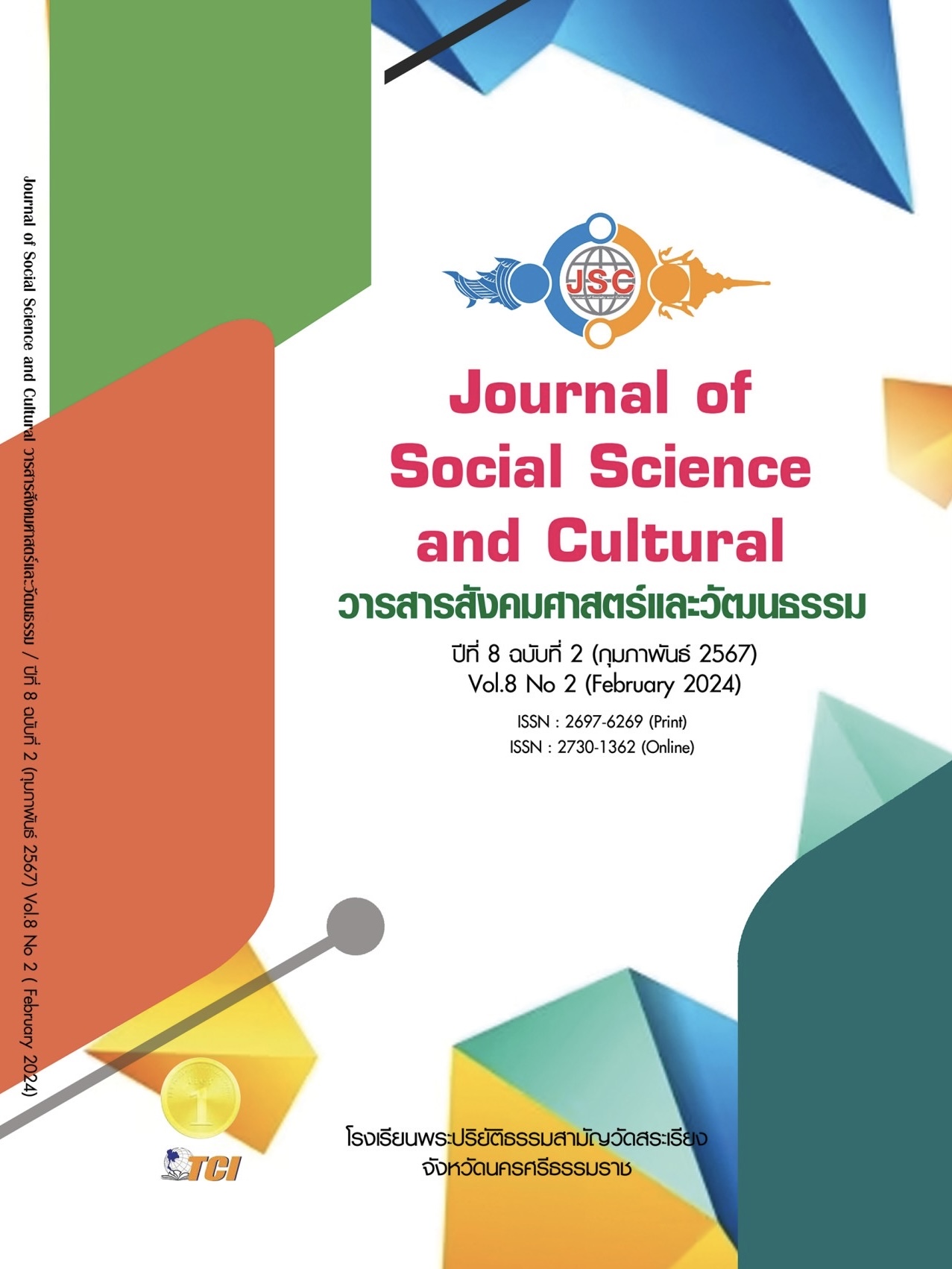GUIDELINES TO INCREASE THE VALUE OF WASTE MATERIALS FROM GROS MICHEL BANANA PSEUDOSTEM FIBER TO FIBERBOARD FOR PRODUCT DESIGN
Main Article Content
Abstract
The objectives of this research were to: 1) study the guidelines to increase the value of waste materials from Gros Michel Banana pseudostem fiber; 2) develop fiberboard from waste materials from Gros Michel Banana pseudostem fiber; and 3) develop products from Gros Michel Banana pseudostem fiberboard. This research utilized a mixed method of qualitative research and quantitative research. This consists of group discussion and participatory action research. The study area is Raimaipattana subdistrict, Cha-am district, Phetchaburi province. The sample group consisted of 30 representatives of Gros Michel Banana farmers and representatives from Wai Wan community enterprises, 5 experts, and 100 home decor enthusiasts. Data collection tools consist of a data collection form and questionnaires. Qualitative data were analyzed using inductive conclusions and quantitative data using percentages, statistics, the mean, and the standard deviation. The results of the research were: 1) Have a participatory action of separating banana sheath fibers using a machine to shear into ropes. Also, husks from separating banana sheath fibers were developed into products for the guideline of increasing the value of waste materials from golden banana husks. 2) Fine and coarse fiberboard sheets made from mixing scraps of flaky fiber and bonding glue for hot extrusion were tested for the physical and mechanical properties of flat plywood sheets according to the standard TIS 876-2547. It was found that the fiberboard passed the quality criteria. 3) Develop fiberboard into five prototypes of the table and chair product set. After being evaluated by an expert, it was found that the one with Piet Mondrian’s art composition idea is the most appropriate. Then, produce a prototype and test it with a sample group. It was found that the average sum of the overall factors is a high level of satisfaction. ( =4.26, S.D. = 0.01)
Article Details
References
บัณฑิตา ใจปินตา และสิทธิศักดิ์ ปิ่นมงคลกุล. (2562). สมบัติทางกายภาพของวัสดุรองนอนสำหรับสัตว์ทดลองจากกระดาษนำกลับมาใช้ใหม่ร่วมกับลำต้นเทียมกล้วย. วารสารวิทยาศาสตร์ คชสาส์น, 41(1), 36-43.
เปรมณัช ชุมพร้อม และคณะ. (2566). การประชุมวิชาการวิศวกรรมโยธาแห่งชาติ ครั้งที่ 28 น. MAT43-1-MAT43-10, 24-26 พฤษภาคม 2566 ภูเก็ต ประเทศไทย. เรียกใช้เมื่อ 30 ตุลาคม 2566 จาก https://www.eng.psu.ac.th/NCCE28-fullpapers/MAT43.pdf.
เพชรบุรีนิวส์. (2565). ต้นกล้วยที่ตัดทิ้งแปรรูปอาหารสัตว์ทำเป็นไซเลจหยวกกล้วยใช้เลี้ยงวัวเพิ่มมูลค่าต้นกล้วยลดต้นทุนในการเลี้ยงโค. เรียกใช้เมื่อ 18 ตุลาคม 2566 จาก https://www.facebook.com/Phetcha buriNews
สํานักงานเศรษฐกิจอุตสาหกรรม. (2563). แนวทางการพัฒนาอุตสาหกรรมไทยตามแนวคิดเศรษฐกิจหมุนเวียน. เรียกใช้เมื่อ 1 มีนาคม 2566 จาก https://www.sdgmove.com/2022/12/09/industrial-deve lopment-implement-circular-economy
สามารถ ใจเตี้ย. (2564). การใช้ประโยชน์วัสดุเหลือใช้ทางการเกษตรของเกษตรกรในเทศบาลตำบลขี้เหล็ก อำเภอแม่ริมจังหวัดเชียงใหม่. วารสารวิจัยและส่งเสริมวิชาการเกษตร, 38(2), 79-88.
สำนักงานเกษตรและสหกรณ์จังหวัดเพชรบุรี. (2566). ข้อมูลพื้นฐานของจังหวัดเพชรบุรี. เรียกใช้เมื่อ 1 ตุลาคม 2566 จาก https://www.opsmoac.go.th/phetchaburi-dwl-files-451991791926
เสน่ห์ สำเภาเงิน และวรัฐฐา คงสม. (2564). การออกแบบผลิตภัณฑ์เชิงนิเวศ กรณีศึกษาโคมไฟร่วมสมัยจากเศษกระจูด. วารสารศิลปกรรมศาสตร์ มหาวิทยาลัยขอนแก่น, 13(2), 148-174.
โสภิดา วิศาลศักดิ์ กุล และ อรวัลภ์ อุปถัมภานนท์. (2566). การศึกษาสมบัติทางเคมีและกายภาพของภาชนะ ย่อยสลายได้ทางชีวภาพจากเปลือกกล้วยน้ำว้าเสริมกาบกล้วย. วารสารวิจัยและพัฒนาวไลยอลงกรณ์ ในพระบรมราชูปถัมภ์สาขาวิทยาศาสตร์และเทคโนโลยี, 18(1), 43-58.
เอนกชิต เกษร และพรรณนุช ชัยปินชนะ. (2565). การสร้างมูลค่าเพิ่มจากเส้นใยกล้วยและกลยุทธ์การจัดการ ผลิตภัณฑ์ของกลุ่มวิสาหกิจชุมชนทอผ้าบ้านเฮี้ยอำเภอปัวจังหวัดน่าน. วารสาร มนุษยศาสตร์ และ สังคมศาสตร์ มหาวิทยาลัย มหาสารคาม, 41(4), 142-154.
Ferdous, S., & Hossain, M. S. (2017). Natural fibre composite (NFC): new gateway for jute, kenaf and allied fibres in automobiles and infrastructure sector. World J Res Rev, 5(3), 35-42.
Jimmim, A. A et al. (2018). Fabrication and characterization of low density particle boards from pseudo-stem of banana plant. In AIP Conference Proceedings, 1980(1),030031.
Sangamithirai, K., & Vasugi, D. (2023). Feasibility of developing Banana- cotton fabric as a Sustainable Textiles. The Journal of Research ANGRAU, 51(2), 89-96.
Sarikahya, E. (2023). The structural formation and expression of morphological and biomorphic composition in geometric abstraction. Premium e-Journal of Social Science (PEJOSS), 7(28), 210-221.
Subagyo, A., & Chafidz, A. (2020). Banana Pseudo-Stem Fiber: Preparation, Characteristics, and Applications. Retrieved April 2, 2023, from https://www.intechopen.com/chapters/64570
Taifa, I. W., & Desai, D. A. (2017). Anthropometric measurements for ergonomic design of students’ furniture in India. Engineering science and technology, an international journal, 20(1), 232-239.
Termpitipong, R. (2020). Banana by-products in Thailand-Exploring its feasibility as bioplastics feedstock for food packaging. Retrieved November 2, 2023, from https://www.lundunIversity.lu.se/lup/publication/9055505
The Bangkok Insight. (2564). ชีวมวล (Biomass) พลังงานสีเขียวเป็นมิตรต่อโลก. Retrieved ตุลาคม 1 , 2566, from https://today.line.me/th/v2/article/1ze83B
TNN ONLINE. (2566). กล้วยหอมไทย ผลไม้ยืนหนึ่ง ราคาสูงผลไม้เศรษฐกิจที่สำคัญที่มียอดการส่งออกมากเป็นอันดับต้น ๆ. Retrieved ตุลาคม 2 , 2566, from https://www.tnnthailand.com/news/


